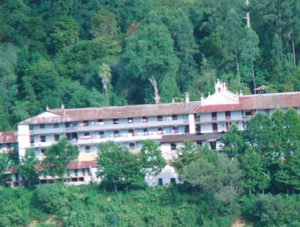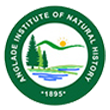Anglade
 The Anglade Institute of Natural history is in the Campus of The Sacred Heart College, Shembaganur (SHC), Kodaikanal, Tamilnadu
The Anglade Institute of Natural history is in the Campus of The Sacred Heart College, Shembaganur (SHC), Kodaikanal, Tamilnadu
This College, at Shembaganur, 1800 m, near Kodaikanal on the Palni Hills, was started in 1895 for Jesuits-in-training. The staff and students in the early years were largely Europeans who were thrilled by the richness and variety of nature on the hills in the country of their adoption, and set themselves to study the flora, fauna and anthropology. Though the members of the team were amateurs, their collections over the years became the most complete natural history heritage of the hills. This entire base (Museum, library, arboretum, fernery and orchidarium) was named as The Anglade Institute of Natural History after Fr. A. Anglade. The following are the main items of interest: Anthropology; Fauna, Arboretum Fernery, and Orchidarium.
The Collection
The historically important collection of Flowering Plants (2891 sheets): S. Munch, who collected first, and A. Anglade, who continued the work, were Professors. A. Sauliere (leader), C. Montaud and G. Rodriguez were students who did the bulk of the collecting during 1913-17. Presumably no field books were kept; however, the information on the labels (mostly locality) is generally correct. The numbers on the labels are really serial numbers given at the time of dispatching the materials for naming to Calcutta 91913-1918 and Kew (1916-1922). One set of duplicates was retained at home.
These collections were first named at Calcutta during 1913-18 (1922); another set was despatched to Kew from 1916 onwards. As for the Kew despatches, the entire correspondence is preserved in the Kew Archives. Some collections went to Bogor, about which no records are known. the significance of this collection is that it antedates Fyson’s regional Flora 9195-21) and Gamble & Fischer’s Provincial Flora (1916-35). In fact Fyson received help from Fr. Gombert before 1910 in naming his collections at the initial stages of his work, as indicated on the labels at PCM. Unfortunately all the came out of this collection was Sauliere’s checklist 989. However, the Kew duplicates were used in Gamble & Fischer’s Flora.
The total holdings in the herbarium now are about 10,000 sheets from duplicates of the (Tamilnadu) Carnatic Flora Project and The Flora of the Palni Hills Project. A valuable collection of 1910 water colour sketches (30 x 24 cm) of the various plants prepared by Anglade, c. 1915-1918, (19: 84-141) is a most useful supplement to the herbarium. Executed even before the regional and provincial Floras were published, these plates have long served in recognizing the plants depicted. There is an earlier collection (1902-10) of 114 (36 x 24 cm) plates of Orchids by Fr. E. Gombert, done with meticulous care as to details, and with excellent notes and even mounted floral parts (19: 192-194.)
Another contribution by Fr. Anglade is the ‘library’ of timbers, consisting of over 300 kinds of timbers of the hills, cut, polished and arranged like books (19: 168-177). The other noteworthy contribution (1960-62) is K.M. Matthew’s collections on the exotic Flora of Kodaikanal. All these collections were remounted at RHT in 1991 and are now is the Anglade Institute as Sacred Heart College.
Environmental Programmes
 The Anglade Institute has the basic facilities for systematic botanists on visit, like the reference herbarium, the accompanying Icones, the library and a working laboratory with microscopes and related equipments but the research facilities are at Tiruchirappalli, the Rapinat Herbarium University base. The role of the Anglade Institute is in environmental work, owing to the situation in a nature sanctuary and the excellent infrastructural facilities. As for environmental research, the Institute works in collaboration with the Palni Hills Conservation Council (PHCC), which has comprehensive eco-restoration programmes for the hills. Both in situ and ex situ programmes are under implementation.
The Anglade Institute has the basic facilities for systematic botanists on visit, like the reference herbarium, the accompanying Icones, the library and a working laboratory with microscopes and related equipments but the research facilities are at Tiruchirappalli, the Rapinat Herbarium University base. The role of the Anglade Institute is in environmental work, owing to the situation in a nature sanctuary and the excellent infrastructural facilities. As for environmental research, the Institute works in collaboration with the Palni Hills Conservation Council (PHCC), which has comprehensive eco-restoration programmes for the hills. Both in situ and ex situ programmes are under implementation.
However, the most significant recent contribution of the Institute is an Environmental Training Programme for students and farmers. Since 1984, a total of 150,000 trainees have been handled in the 3-days’ programme. The strategy was to arouse environmental awareness and the possibility of eco-restoration around the Watershed concept and the indispensable role of the primary vegetation in maintaining eco-system balance, eventually leading to appropriate action. The key insight is that tomorrow’s planners, decision-makers and executives should be handled today, in their most formative years. Methodology: Day : Introduction to the past natural history wealth of the hills as preserved in the Institute’s Museum, herbarium, gardens and library; Day 2: Introduction to the present through field visits, leading to a real, firsthand comparison of the two; Day 3: evaluation, initiation into afforestation work from seed collection to planting of seedlings, followed by devising suitable action programmes back home. The Newsletter SHOLA (‘evergreen forest’) links the participating groups; periodic visits to the institutions by our staff ensure reliable monitoring of follow-up action, and timely encouragement. suitable variations are made for farmers and similar groups. A Leadership Programme of a week’s duration is devised for environmental workers in need of additional inputs.
The Emblem
 Four ideas are stressed in the emblem of the Institute: (a) The two constituents of the primary vegetation of the hills (the home of wildlife, the source of genetic diversity and food chain, and the very base of watershed), namely, sholas (evergreen forests) below and Grasslands above appear in sharp relief; (b) the sun represents the source of energy, the only unlimited capital on this fragile and ever-depleting planet; (c) the cascade stands for the flow of life; (d) this water stored below indicates wetlands which are the home of watershed. This water slowly being released all round indicates the environmental awareness generation that takes place at the Institute.
Four ideas are stressed in the emblem of the Institute: (a) The two constituents of the primary vegetation of the hills (the home of wildlife, the source of genetic diversity and food chain, and the very base of watershed), namely, sholas (evergreen forests) below and Grasslands above appear in sharp relief; (b) the sun represents the source of energy, the only unlimited capital on this fragile and ever-depleting planet; (c) the cascade stands for the flow of life; (d) this water stored below indicates wetlands which are the home of watershed. This water slowly being released all round indicates the environmental awareness generation that takes place at the Institute.